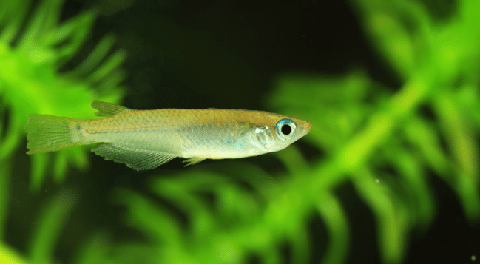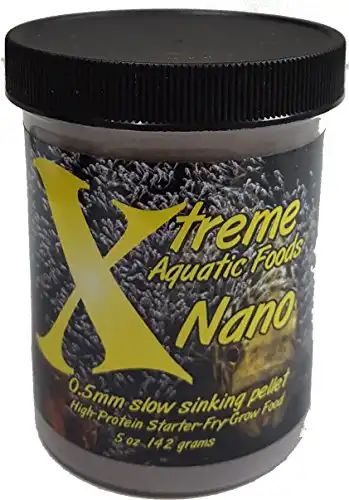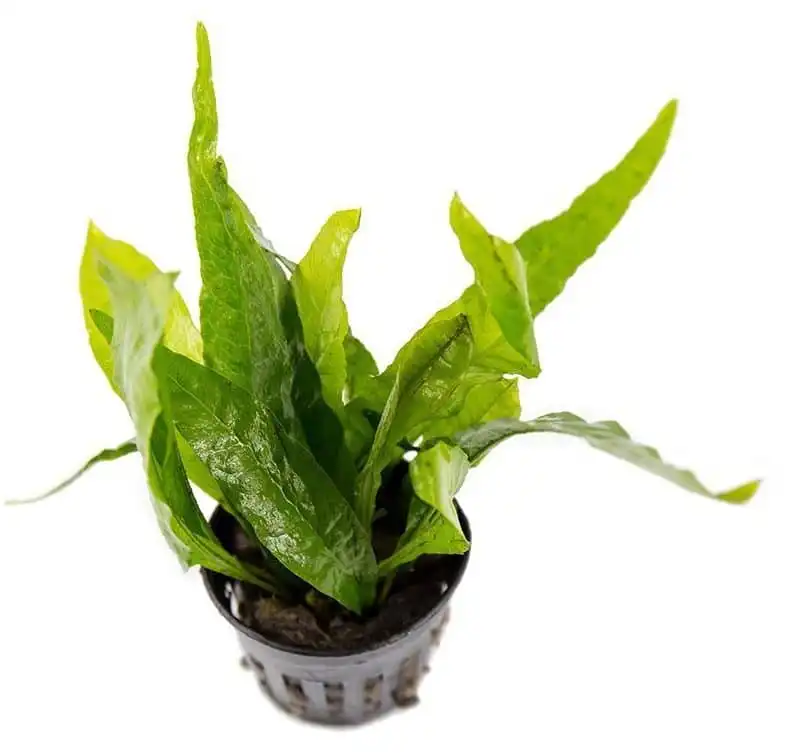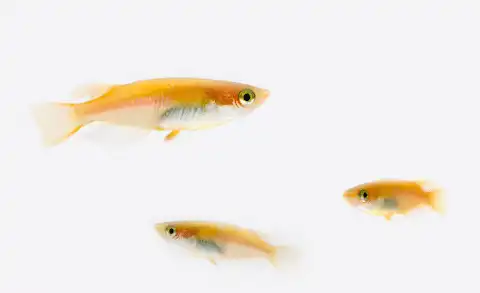Thank you for visiting! By the way… any links on this page that lead to products on Amazon and other stores/partners are affiliate links Aquarium Store Depot earns a commission if you make a purchase.
The Japanese rice fish (Oryzias latipes) is a peaceful nano species that is becoming increasingly popular among aquarists. These fish are highly underrated in the hobby, being one of the hardiest coldwater nano fish choices.
Read on to learn everything you need to know about keeping and breeding these adaptable fish!
Brief Overview of the Japanese Rice Fish
| Scientific Name | Oryzias latipes |
| Common Names | Japanese rice fish, Japanese killifish, Medaka |
| Family | Adrianichthyidae |
| Origin | Japan, China, Vietnam, Laos, Taiwan, & Korea |
| Diet | Omnivore |
| Care Level | Easy |
| Activity | Moderate |
| Lifespan | 2-5 Years |
| Temperament | Peaceful |
| Tank Level | Midwater, Top |
| Minimum Tank Size | 10 gallons |
| Temperature Range | 61°F – 75°F |
| Water Hardness | 5-25 dKH |
| pH Range | 7.0 – 8.0 |
| Filtration/Water Flow | Low |
| Water Type | Freshwater, Brackish water |
| Breeding | Egg-layer |
| Difficulty to Breed | Easy |
| Compatibility | Species-only tank or community tank |
| OK, for Planted Tanks? | Yes |
Japanese Rice Fish Origins and Habitat
Japanese rice fish are small schooling fish that are native to Southeast Asia from eastern China and eastern Korea to Japan and Vietnam. Phylogenetic analysis has shown that there are actually 33 closely related species in the genus Oryzias.
The Japanese rice fish has a rich history in the aquarium hobby. They have been a favorite among Asian aquarists for centuries! These celebrated fish look amazing when viewed from above, which was important before glass fish tanks became available.
Rice fish are highly adaptable fish that are found in a variety of habitats like rice paddies and shallow rivers. They occur naturally in both freshwater, and brackish water where fresh and saltwater mix according to the tides. Check out the video above from my YouTube channel. There is more information on this post so let’s keep reading on!
What Do They Look Like?

The first thing you might notice about rice fish is that they are almost transparent! They also have beautiful big blue eyes.
Japanese rice fish have been selectively bred to produce beautiful and fairly stable color varieties. There are hundreds of known rice fish breeds, but the following types are most accessible in the hobby.
- Pink Medaka Rice Fish
This variety is one of the most colorful ricefish available in the hobby. The Pink Medaka Rice Fish have an orange-pink body color that brings life to any fish tank.
- Galaxy Medaka
The galaxy rice fish has a whitish body color. Under good lighting, their scales shine like a rainbow. Like other rice fish varieties, these fish look almost transparent.
- Red Cap Medaka
This stunning color form of the Japanese rice fish has an orange/red crown and back that merges into its pearl-colored body. This combination of color contrasts amazingly with their bright blue eyes.
- Yokihi Medaka Rice Fish
The Yokihi medaka is a rare breed with beautiful deep orange coloration.
Other Ricefish Species
- Javanese Medaka Rice Fish
The Javanese rice fish (Oryzias javanicus) is actually a different species from the Japanese rice fish. These beautiful little fish are from more tropical areas and are suitable for heated tropical fish tanks. It can be told from the Japanese rice fish by its deeper body shape and pointed tail fin.
- Woworae Medaka Rice Fish
The woworae, or Daisy’s blue rice fish (Oryzias woworae) is one of the most colorful tropical Asian medakas in the genus Oryzias. This awesome little nano species wows fishkeepers with its bright orange body trim and pectoral fins. The males, in particular, have a beautiful blue glowing body color, although both sexes boast bright blue eyes.
How Big Are They
Medaka are very small fish that reach a maximum length of between 1 and 1.4 inches. Their small size and hardiness make them great fish for nano tanks.
How Long Do They Live?
Rice fish, like most nano species, are not particularly long-lived fish. With good care, however, these fish can live for as long as 5 years. The most important factors that affect the longevity of your fish are:
- Water quality
- Water temperature and parameters
- Feeding
- Disease & stress prevention
Fish Temperament and Activity Level

Japanese ricefish are relatively active little fish that spend most of their time in the midwater of the aquarium. It is best to keep your ricefish in a group of at least 8.
They are not shy if kept in a comfortable environment and will usually be found schooling together in an open area of the tank outside of the current created by your filter. Rice fish are very peaceful, so you don’t have to worry about any bad behavior in a community fish tank.
Interestingly, the hardy and adaptable nature of these fish have made them a popular model for scientific research and education. Believe it or not, they were the first vertebrate species to be bred in space!1
What Are Good Tank Mates for Them?
Japanese rice fish are very peaceful creatures that get along great with other species of fish in a community tank. They are very small, so it’s important to avoid larger fish that might see them as dinner.
Choosing fish that are similar or the same size is the best way to avoid any disappearances, but there are other factors you need to consider when planning a peaceful community.
Firstly, Japanese ricefish are considered cold water fish, so they should not be kept in water temperatures higher than the mid-70s. They may survive in a tropical setup, but their lifespan will probably be reduced, so keep them on the cooler side.
The fact that they thrive in cooler water temperatures is actually a real bonus for aquarists looking to set up a cold water community tank. Let’s take a look at some of the freshwater fish species that you can keep with medaka.
Best Tank Mates
- Fancy goldfish
- White cloud minnows
- Endler’s livebearers
- Celestial pearl danios
- Asian stone catfish
- Adult shrimp
- Nerite snails
Least Compatible Fish for Companions
- Bettas
- Pufferfish
- Angelfish
- Tiger barb
- Discus and other fish that require high water temperatures
- African cichlids
- Oscars
What Do They Eat?
Ricefish are not very picky when it comes to diet. The most important factor to consider is their small size.
Ricefish can be fed a diet of dried prepared foods like pellets, granules, or flakes. Flakes can easily be crushed up, but harder foods like pellets need to be very small.
Rice fish are said to be omnivorous, which means they are both animal and plant eaters. Small insects and other tiny animals are an important component of their diet, and these should be provided as a supplement to keep them in great health. This is also very important to bring your ricefish into top breeding condition. A good staple food to try would be Xtreme Aquatics Nano formula.
Xtreme Aquatics Nano formula is specially designed for smaller fish and contained a well balance mix of raw ingredients. It is a great staple food for your nano fish.
Here are a few great supplementary frozen and live foods that you can provide:
- Blood worms
- Brineshrimp
- Daphnia
- Grindal worms
- Small vegetables
How Much and How Often to Feed Them
Aquarists often make the mistake of overfeeding their pets. This can result in obesity, and more importantly, reduced water quality. So how do you know how much food to provide?
Feeding them more than once a day is a great tip. Providing a small amount that they can finish in just a minute or so will prevent any uneaten food from sinking to the bottom or getting sucked into your filter.
If your medaka fish are colorful, growing, healthy, and active, you know you’re keeping them well fed!
Setting Up Your Tank
Japanese ricefish are very easy to care for and will thrive in a variety of setups. In fact, many aquarists keep these hardy freshwater fish outdoors in ponds and containers.
They will thrive in any setup that provides an environment that is similar to their natural habitat. In this section, you can learn how to set up a great tank for your rice fish, so let’s get started!
Tank Size
Rice fish are a nano species that can survive in aquariums as small as a few gallons or as big as outdoor ponds! I would recommend starting out with a tank of 10 gallons or larger, however, because this provides enough swimming space for a nice school while being stable enough to maintain water quality.
More important than the size of the tank is its cover. These little jumpers can easily escape out of an open aquarium, so make sure it has a secure lid.
Aquarium Plants
Rice fish absolutely thrive in a planted aquarium. They feel more comfortable with floating plants on the water surface. That doesn’t mean you can’t keep medaka, without live plants, however.
You might think growing live plants requires special lighting, equipment, and soils, but that doesn’t have to be the case.
Start out with a few easy aquarium plants like Java ferns and anubias to green up your aquarium. These plants will grow under standard aquarium lighting if tied to your hardscape.
Java Fern is one of the easiest and hardiest live plants you can purchase
If you want to upgrade your tank into an amazing underwater aquascape, you can look at starting a tank with decent aquarium soil, good quality lights, and a pressurized CO2 injection system.
Substrate
A darker, natural colored substrate tends to bring out the best color in aquarium fish, and also makes them feel more at ease. Any aquarium-safe substrate can be used, however, since ricefish will not spend much time at the bottom of the tank.
If you’re setting up a planted aquarium, starting out with a quality aquarium soil will provide the best results. Alternatively, a well-rinsed sand or gravel substrate will work great.
Decor
Arranging some rocks or driftwood in the aquarium is a great way to make a natural environment for all the fish, and a more attractive aquarium for you to look at too. Be sure to use clean, aquarium-safe materials and place them carefully to prevent any damage to the glass.
Water Quality
Keeping the water clean and safe is the next priority after setting up a great tank for your ricefish. The tank should be fully cycled before introducing the fish. Check out this article if you’d like to learn more about the aquarium cycle and why it’s so important.
Let’s take a look at how to keep your cycled aquarium safe and healthy for your fish.
Filtration
Many aquarists will tell you a filter is not essential for keeping ricefish. I recommend good filtration for all aquariums just because they are so effective for maintaining the nitrogen cycle, aerating the water, and of course, filtering out particles and impurities in the water.
A simple sponge filter works great, but if you plan on keeping many fish or a community setup, consider upgrading to a canister filter. Both of these filter types create very little flow, which is ideal for these freshwater fish that prefer living in calm water.
Water Parameters
One of the great things about ricefish is how hardy and adaptable they are. Chances are, the temperature in your home is very comfortable for them, and this means most keepers don’t need aquarium heaters.
Here are the most important water parameters that you should maintain for your rice fish:
- Water Temperature: 61°F – 75°F
- pH: 7 – 8
- Hardness: 5-25 dKH
- Ammonia: 0 ppm
- Nitrite: 0 ppm
- Nitrate: < 20 ppm
Aquarium Maintenance
Keeping your aquarium clean and healthy is the most important thing you can do for your ricefish. Here are some of the steps you’ll need to take:
- Perform a regular water change every week or two
- Suck up uneaten aquarium fish food and waste from the substrate with your gravel vac
- Clean your aquarium glass with an algae scraper when necessary
- Rinse out your filter media with old tank water on a regular basis
Test Tank Conditions
The only way to really know if your water parameters are suitable for your ricefish is by testing your water regularly. This will also tell you if your maintenance schedule is up to scratch.
Testing your water is easy with an aquarium test kit. These kits come in liquid or strip form and are easy (and fun) to use.
Breeding
Rice fish are easy to breed in the home aquarium. Read on to learn how (I’ve also provided a video from Aquaviva below)!
Sexing
Of course, you’re going to need both male and female ricefish if you want them to reproduce. But how do you know which sex they are? Here’s what to look for:
- Adult female rice fish are usually larger than males
- Females often carry eggs on their anal fins
- Males tend to be more colorful
- Males have a small bump on the body in front of the anal fins
- Male ricefish also have longer rays in the dorsal and anal fin
Getting Ricefish Ready to Breed
Conditioning your fish is very important since unhealthy ricefish will produce fewer eggs, or they might not reproduce at all. Feed your fish a healthy diet of frozen and live food before you plan on breeding them to increase your success rate.
The Breeding Process
Once the female is in breeding condition, she will lay eggs every day for several weeks or even months. The male fertilizes them and then the adhesive eggs are deposited on fine-leaved plants like Java moss.
Spawning mops made from green wool or synthetic fibers can also be used to simulate a live plant.
Caring For Fry
The fertilized eggs will hatch after 2 weeks or so. The fry will need to be fed infusoria or liquid fry foods due to their small size. Live plants and the tiny animals that grow on them can provide a great natural food source too.
The fry are vulnerable to larger fish at this age, which is why spawning them in a dedicated spawning tank is the safest option. The fry grow quickly, however, and can reach maturity in less than 6 months.
Health and Disease
Japanese rice fish are very hardy, but there is always a chance that your fish may develop health problems. Read on to learn more about what to look out for.
Evaluating Your Ricefishes’ Health
The easiest way to assess the health of your fish is to observe their physical characteristics and their behavior. Fish that are hiding, breathing rapidly, or have lost all of their usual colors are showing signs of stress.
Flashing against the substrate, floating, or sinking are other common signs of distress. Observing your fish often will help you pick up problems early, and allow you to notice changes over time.
Common Ricefish Health Issues
- Fungal infections
- White spot disease
- Fin rot
Where To Buy
You don’t have to travel to Japan to get your own beautiful medaka rice fish. Sure, they aren’t always the easiest fish to find at your local pet store, but in today’s world of online fish stores, that’s no problem at all! You can click the link below to check out the variety of rice fish available for sale by our partners.
Japanese rice fish are a commonly overlooked fish suitable for freshwater aquascapes. Very peaceful and hardy fish that color up with companions
Frequently Asked Questions
What do they eat?
Japanese ricefish are not fussy when it comes to food. Feed them a regular diet of flakes or micro pellets. Providing live foods like baby brine shrimp and micro worms is a great way to keep them in perfect health.
Are ricefish aggressive?
Rice fish are not aggressive at all. These peaceful nano fish are great community tank mates.
Why are they called ricefish?
Rice fish get their name from their habit of living in rice paddies. These are shallow swamps where the rice plant is grown.
Are ricefish the same as killifish?
Ricefish may look and act a lot like killifish but they are not all that closely related. Genetic research has shown that ricefish are in the Adrianichthyidae family while killifish are in other families like the Aplocheilidae and Fundulidae.
How long do ricefish live?
You can expect your ricefish to live for a few years if you provide it with the right care. Their expected lifespan is anything from 2 to 5 years.
Closing Thoughts
Medaka rice fish are kept everywhere from Japan to space! It’s a shame that these coldwater nano fish aren’t better known, but fortunately, they have become more accessible all over the world in modern times.
Do you keep Japanese rice fish? Let us know about your experiences with these nano fish in the comments below!
- About the Author
- Latest Posts
I’m thrilled that you found Aquarium Store Depot! Here you’ll find information on fish, aquariums, and all things aquatics related. I’m a hobbyist (being doing this since I was 11) and here to help other hobbyists thrive with their aquariums! I adhere to a high quality Editorial Process and Review products with real life field usage and practical analysis.








